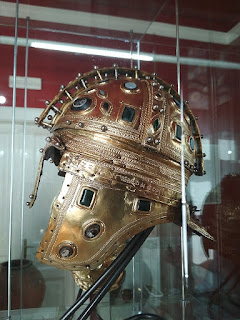In his book, The Armour of Imperial Rome, published in 1975, British classicist H. R. Robinson identified 30 different types of cheek guards. However, Robinson's typology has been heavily criticized by other scholars as too rigid and closed to adapt to new discoveries. Thomas Fischer, author of "Army of the Roman Emperors, Archaeology and History," points to the systematic identification of every elaborate ornate cavalry helmet as parade armor that resulted in hardly any of the recovered helmets from the 2nd and 3rd centuries CE as regular cavalry helmets. He observes that on the basis of finds made at Ostrov and Tell Oum Hauran, ornamentation alone was not enough to assign a helmet to parade armor.
"...these assemblages contained two ornate helmets: one with a face-mask and one without a mask. It seems logical that the latter was the piece for everyday use and combat."
The oldest recovered Roman helmet dates to the 3rd century BCE. It was recovered from Pizzighettone near Cremona. It was so similar to helmets used by the Etruscans, it took some time before it was finally accepted as a piece of Roman armament. It has been designated as a Montefortino type and was relatively unadorned. This helmet with cheek pieces was used for about 300 years. During Caesar's Gallic Wars, the Montefortino helmet type has been found along with the Mannheim type. Unfortunately no cheekpieces have been found with the Mannheim type, although holes for cheekpiece attachment are present. During the Gallic Wars, the Celtic Port-type iron helmet, with higher bowl and separately attached neck guard, was adapted. During the Augustan period the Port-type was transformed into what is now referred to as the Weisenau type.
Ornamentation became more pronounced with the Weisenau type helmet. A helmet now known as the Gutmann variant displays an engraved ornamentation on its cheekpiece. Rivets added to cheekpieces for strength were sometimes capped with florets. These florets were sometimes combined with enamel-filled rivet heads, embossed strips, edging and ornamental sheet appliques. The helmet bowl itself began to exhibit what is termed "stylized eyebrows" as well.
As the 1st and 2nd century CE progressed, the cheekpiece became wider and wider, especially those of the cavalry. They were always decorated and on the part covering the ear was usually an embossed replica of the ear. The earplate itself was perforated to improve hearing. These helmets were so distinctive, scholars gave them the subtype designation of Neiderbieber type. By the middle of the 4th century CE, cheek pieces covered so much of the facial region they left just the eyes and nose exposed.
 |
| A ridged cavalry helmet of the Deurne-Berkasovo type with jewel-studded cheekpieces at the Vojvodina Museum at Novy Sad courtsy of Wikimedia Commons contributor Filip Popovic |
 |
| Fragment of a Roman cheekpiece, 3rd century CE at the Roman museum Kastell Boiotro ( Passau ) courtesy of Wikimedia Commons contributor Wolfgang Sauber |
 |
| A cheekpiece from the Hallaton Cavalry Sports Helmet Type 1, cheekpiece courtesy of Wikimedia Commons contributor Prioryman |
 |
| Part of a Roman cavalry parade helmet with relief of a bacchant at the Archaeological Museum Gunzenhausen in Bavaria courtesy of Wikimedia Commons contributor Wolfgang Sauber |

No comments:
Post a Comment